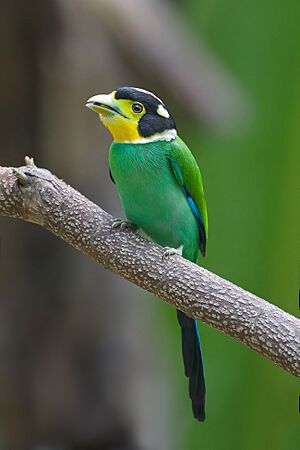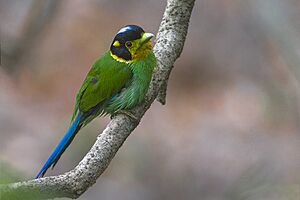Long-tailed broadbill facts for kids
Quick facts for kids Long-tailed broadbill |
|
|---|---|
 |
|
| Conservation status | |
| Scientific classification | |
| Genus: |
Psarisomus
|
| Species: |
dalhousiae
|
The long-tailed broadbill (Psarisomus dalhousiae) is a colorful bird found in the Himalayas and across Southeast Asia. It's the only bird of its kind in the Psarisomus group. This bird is about 25 cm (10 inches) long and weighs around 50 to 60 grams. You might recognize it by its loud, sharp calls!
Long-tailed broadbills have bright yellow feathers on their throat. Their belly, back, and wings are a pretty bluish-green color. These birds live in forests and mostly eat insects. They are very social and usually travel in big, noisy groups, except when it's time to breed. They build a pear-shaped nest in a tree. The female bird lays about 5 to 6 eggs. Both parents take turns sitting on the eggs and feeding the young chicks.
Contents
About the Long-tailed Broadbill
The long-tailed broadbill is a type of songbird (Passeriformes). It belongs to the Eurylaimidae family, which are birds known for their wide heads and flat, broad beaks. As mentioned, it's the only bird in its specific group, called Psarisomus. The scientific name, dalhousiae, honors Christina Broun, Countess of Dalhousie (1786–1839).
Scientists recognize five different types, or subspecies, of the long-tailed broadbill:
- P. d. dalhousiae: Found in the Himalayan foothills, from northern India to parts of China, Thailand, Laos, and Vietnam.
- P. d. cyanicauda: Lives in southeastern Thailand and Cambodia.
- P. d. divinus: Found in southern Vietnam.
- P. d. psittacinus: Lives in Peninsular Malaysia and Sumatra.
- P. d. borneensis: Found in northern Borneo.
What Does it Look Like?
Adult long-tailed broadbills are quite striking. They have a bright yellow throat and face, with yellow feathers extending around their neck. Their head has a black, helmet-like cap with a shiny blue patch on top and another blue patch at the back of their neck.
The feathers on their back, belly, and the top of their wings are a bright green. This green color comes from a mix of pigments and how their feathers are built. The underside of their wings is a lighter green or bluish-green. Their main flight feathers are black, with a metallic blue edge and a white spot.
These birds have a long blue tail, but the feathers underneath are black. Their strong, wide beak is yellowish-green with lighter edges. They have pea-green toes and brown legs. Young broadbills have shorter tails and duller green feathers on their heads. A fully grown adult is about 25 cm (10 inches) long and weighs between 50 and 60 grams.
Where Do They Live?

Long-tailed broadbills are found in the Himalayas and Myanmar. They also live in different parts of Southeast Asia, including the Malay Peninsula, Sumatra, and Borneo. You can find them in countries like India, Nepal, Bhutan, Myanmar, Thailand, Cambodia, Laos, Vietnam, China, Malaysia, and Indonesia.
They prefer to live in broad-leaved evergreen forests, usually at altitudes from 150 to 2500 meters (about 500 to 8,200 feet). They like places near small bodies of water, such as streams and wetlands. These birds do not migrate, meaning they stay in the same area all year. However, those living in higher parts of the Himalayas might move to lower areas during cold winter months.
How Do They Behave?
Long-tailed broadbills are social birds. They are often seen searching for food in small groups. Sometimes, they even join flocks with other types of birds. Even though they make loud, high-pitched calls, they are quite shy. They usually hide among the leaves of trees. They become especially noisy during their breeding season.
What Do They Eat?
These birds are insect-eaters. They spend their time looking for small insects in the forests. During times when they are not breeding, they can be seen foraging in groups of up to 15 birds. Their diet mainly includes grasshoppers, crickets, locusts, beetles, aphids, flies, bugs, moths, and spiders. Sometimes, they might also eat small frogs, berries, and other fruits.

Reproduction and Nesting
The time when long-tailed broadbills breed can change depending on where they live. In the Indian Subcontinent, they breed from March to April. In Myanmar, they start breeding in April. The female bird lays about 5 to 6 white, oval-shaped eggs. Both the male and female broadbills help to incubate the eggs and feed the young chicks. It's even thought that more than two adults might help care for the young, suggesting they could be cooperative breeders.
They build a large, pear-shaped nest that hangs from a branch of a tall tree. The nest has a small, round entrance, about 1 to 2 inches wide, on its side. This entrance is usually hidden by a cushion of leaves. The nest is made from fine roots, dead leaves, vines, moss, and other plant materials. Once the young birds are old enough to be on their own, they often move to new spots within their habitat.
What Do They Sound Like?
The long-tailed broadbill's call is a series of loud, sharp whistles that go down in pitch, sounding like "pseeu...pseeu...pseeu" and "tseeay...tseeay." They might also make a sharp, rough "pseeup" sound.
Conservation Status
The ICUN Red List of Threatened Species says that the long-tailed broadbill is of "least concern." This means they are not currently considered endangered or at high risk. They are quite common in the areas where they live and are protected in many national parks.



